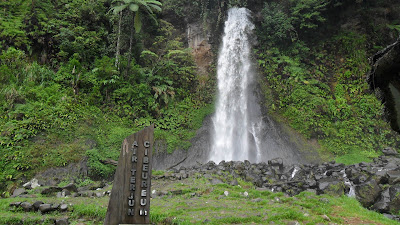Kawah Putih or in English is White Crater is a striking crater lake and tourist spot in a volcanic crater about 50 km south of Bandung in West Java in Indonesia.
Kawah Putih lake (7.10° S 107.24° E) is one of the two craters which make up Mount Patuha, an andesitic stratovolcano (a "composite" volcano). Mt Patuha is one of numerous volcanoes in Java. Kawah Putih crater lake itself represents a relatively stable volcanic system with no records of significant activity since around 1600.
The Kawah Putih site was opened to visitors in 1987. The lake is 2,430 meters above sea level so the local climate is often quite chilly (temperatures are frequently around 10 degrees Celsius). This makes a brisk change from the humidity of the north Java plain and the capital city of Jakarta. Kawah Putih is a sizeable highly acid lake (pH 0.5-1.3) which changes colour from bluish to whitish green, or brown, depending on the concentration of sulfur and the temperature or the oxidation state.The sand and rocks surrounding the lake have been also leached into whitish colours through interaction with the acidic lake waters (with possible mineral precipitation as well).
 |
| Source : http://kawahputihciwidey.com/wp-content/uploads/2016/08/mysterious-yet-beautiful-crater-of-kawah-putih-bandung-admire-kawah-putih-lake-kawah-putih-lake-768x510.jpg |
 |
| Source : http://kawahputihciwidey.com/wp-content/uploads/2016/08/kawah-putih-ciwidey-kawah-putih-ciwidey-ciwidey-white-cra-flickr-kawah-putih-lake-kawah-putih-lake-768x576.jpg |
Access to This Place
Access is gained from the left of the main road travelling south by entering the park and proceeding along a 5 km access road. Travel time from the centre of Bandung, depending on traffic in and around Bandung, is perhaps two hours. The turnoff from the main road to Kawah Putih is hard to miss: there is a large signboard to the left of the main road and a prominent entry gate. The entry facilities and the crater location are well-managed by staff from the state-owned forestry firm Perhutani.
The usual arrangement is for visitors to leave their vehicles in a main carpark at the entry to the site and catch one of the regular mini shuttlebuses (leaving every five minutes or so) for the 5 km to the crater. For Indonesian citizens, the cost of entry to the site (October 2011) is Rp 15,000 plus Rp 5,000 for the return minibus ride (total of Rp 20,000, around $US 2.20). Charges for foreign visitors are slightly higher. Visitors who prefer to drive in their own vehicles up to the crater must pay a significantly higher charge (Rp 150,000, or $US 17 per vehicle plus tickets for passengers). Tickets are issued by Perhutani staff and include insurance while at the location.
The main road is the busy road south from Bandung through the town of Soreang, the capital of the Bandung District, continuing down through the crowded Pasir Jambu township. Minibuses ply the route southwards from Bandung and, depending on traffic, can take up to two hours to reach the entrance to the Kawah Putih area. There are many thousands of small market-crop farmers in the fertile valley to the south of Bandung which leads up towards the Kawah Putih area. Local food-crops grown include a wide range of fruits and vegetables. A strawberry industry is well-established in the area and many strawberry farms have fruit for sale along the side of the highway.
Accommodation is available at various hotels in the Patuha area close to the nearby town of Ciwidey and also in Soreang.



















